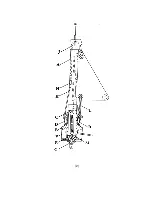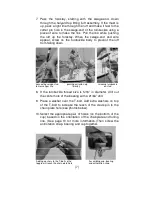
To furl or reef, ease the sheet and pull the furling line until you
reach the amount of sail you wish left deployed. Cleat down
the furling line. Note: Letting the sheet go all the way may
make furling a little easier but will result in an uneven furl.
To unfurl or unreef, ease the furling line while trimming the
sheet. Always keep some tension on the furling line to insure a
smooth wrapping of the furling line on the drum.
In certain conditions, you may wish to use a winch to get the
furling started. Be careful that there is no extraneous ship’s
halyard wrapped in the furler while you winch as this could
eventually jam the furler and/or damage the headstay. Always
look up at the top of the furler while winching, and stop to clear
any snarls. Furling should not get any more difficult as the sail
is brought in. It should get easier. If it gets harder, stop and
determine why.
Always keep unused halyards flipped aft of the spreaders and
lightly tensioned. Do not clip them to the bow.
TRAILERING WITH YOUR FLEXIBLE FURLER
Your Flexible Furler is designed to take a lot of abuse.
However, if you plan to trail your boat, there are some
precautions that will help avoid problems not normally
experienced while sailing.
If you leave the furler lashed along the mast while trailering,
do not let the furler sag in the middle or at the ends. Pay
particular attention to the bottom end as it will probably
overlap the bottom of the mast and tend to bounce. To support
the drum/cup assembly, lash an extension to the bottom of the
mast and tie the bottom of the furler to the extension. Do not
bend the furler on itself to prevent whipping.
Never lash or store the furler in such a way as to cause a
sharp bend. The luff will “remember” the bend. If this
inadvertently happens, it is not covered under the warranty,
but can be straightened by bending the luff in the opposite
sense until it comes straight. Another option is to put the luff in
a pipe or tube outside in the sun for one to two weeks to
straighten it.
(13)
Summary of Contents for FLEXIBLE FURLER 2
Page 4: ... 2 ...


















